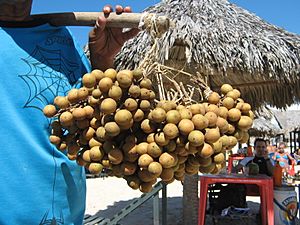Talisia esculenta facts for kids
Quick facts for kids Talisia esculenta |
|
|---|---|
 |
|
| Scientific classification | |
| Genus: |
Talisia
|
| Species: |
esculenta
|
The Pitomba (scientific name: Talisia esculenta) is a medium-sized tree that grows naturally in the Amazon Basin. You can find it in countries like Brazil, Colombia, Peru, Paraguay, and Bolivia.
People call this tree and its fruit pitomba in English, Portuguese, and Spanish. In Portuguese, it's also known as olho-de-boi, pitomba-rana, and pitomba-de-macaco. The French call it pitoulier comestible, and in Spanish, it's sometimes called cotopalo. The Guarani people know it as karajá bola. It's good to know that the name pitomba is also used for another fruit tree called Eugenia luschnathiana.
Contents
What Does the Pitomba Tree Look Like?
The Pitomba tree, or Talisia esculenta, can grow quite tall, reaching heights of 9 to 20 meters (about 30 to 65 feet). Its trunk can become as wide as 45 centimeters (about 18 inches) across.
Leaves and Flowers of the Pitomba Tree
- The leaves of the Pitomba tree grow in a special pattern, one after another along the stem.
- Each leaf is made up of smaller parts called leaflets, usually 5 to 11 of them.
- These leaflets are about 5 to 12 centimeters (2 to 5 inches) long and 2 to 5 centimeters (1 to 2 inches) wide.
- The tree produces small, white flowers.
- These flowers grow in clusters called panicles, which can be 10 to 15 centimeters (4 to 6 inches) long.
The Delicious Pitomba Fruit
- The fruit of the Pitomba tree is round or oval-shaped.
- It measures about 1.5 to 4 centimeters (0.6 to 1.6 inches) across.
- Underneath its outer skin, the fruit has a white, see-through pulp.
- This pulp tastes sweet and a little bit sour, which makes it very refreshing.
- Inside the pulp, there are usually one or two large, long seeds.
How Do People Use Pitomba?
The Pitomba fruit is very popular in the regions where it grows.
- Eating Fresh and Juices: Most people enjoy eating the fruit fresh, right off the tree. It's also often used to make delicious and refreshing juices.
- Traditional Uses: In some areas, the sap (liquid inside the tree) has been traditionally used as a way to catch fish. The roasted seeds of the Pitomba fruit have also been used in traditional medicine to help treat diarrhea.

